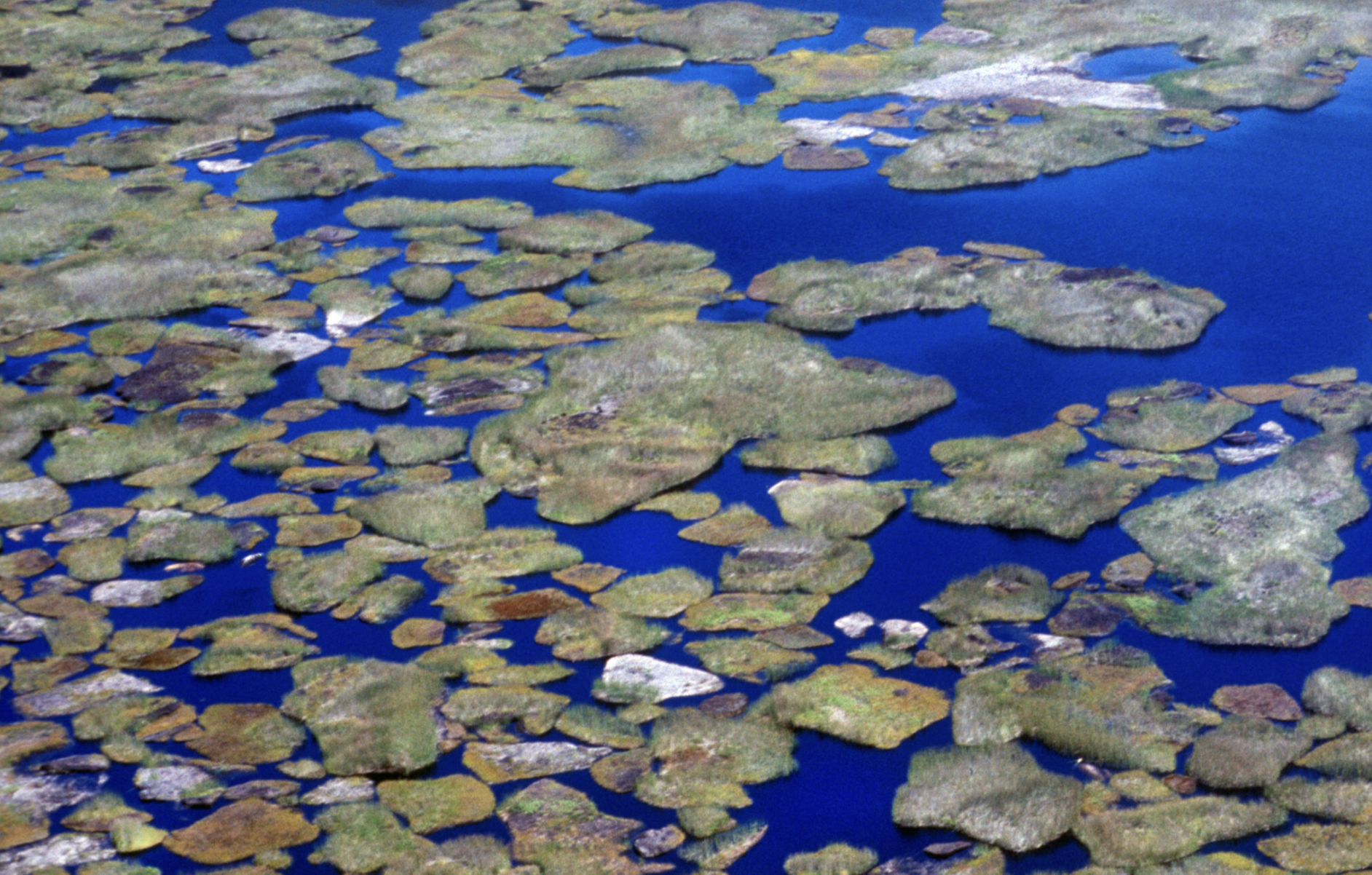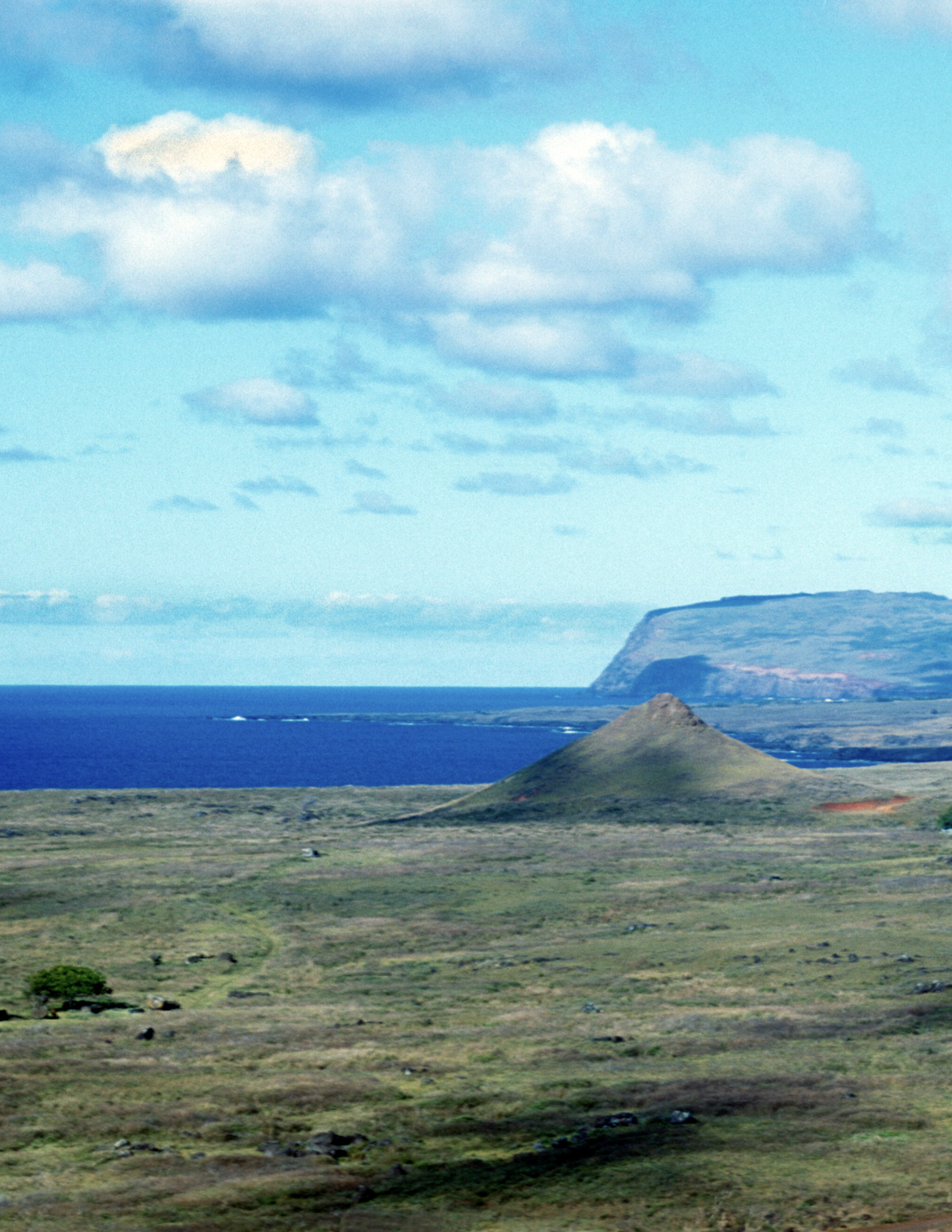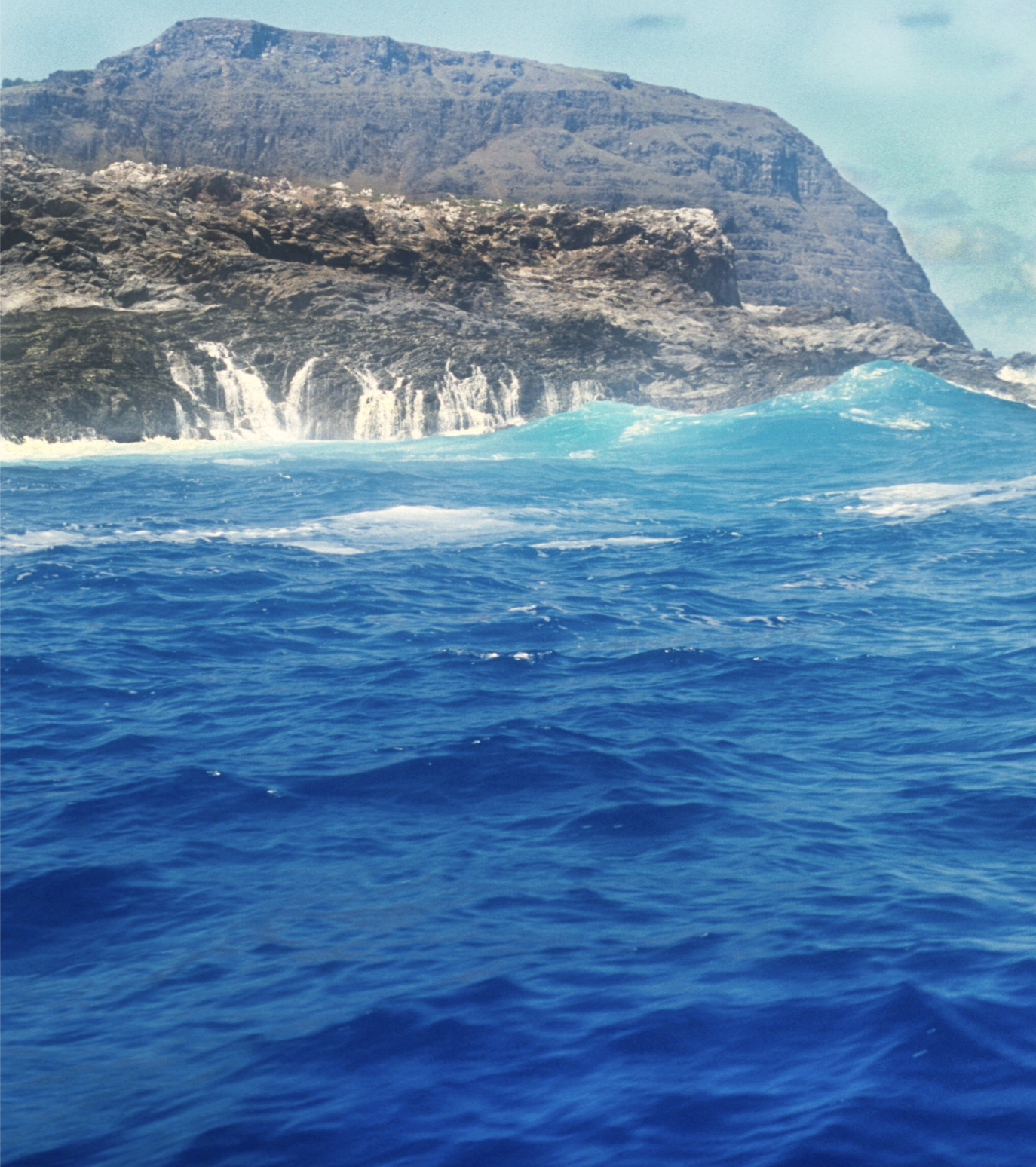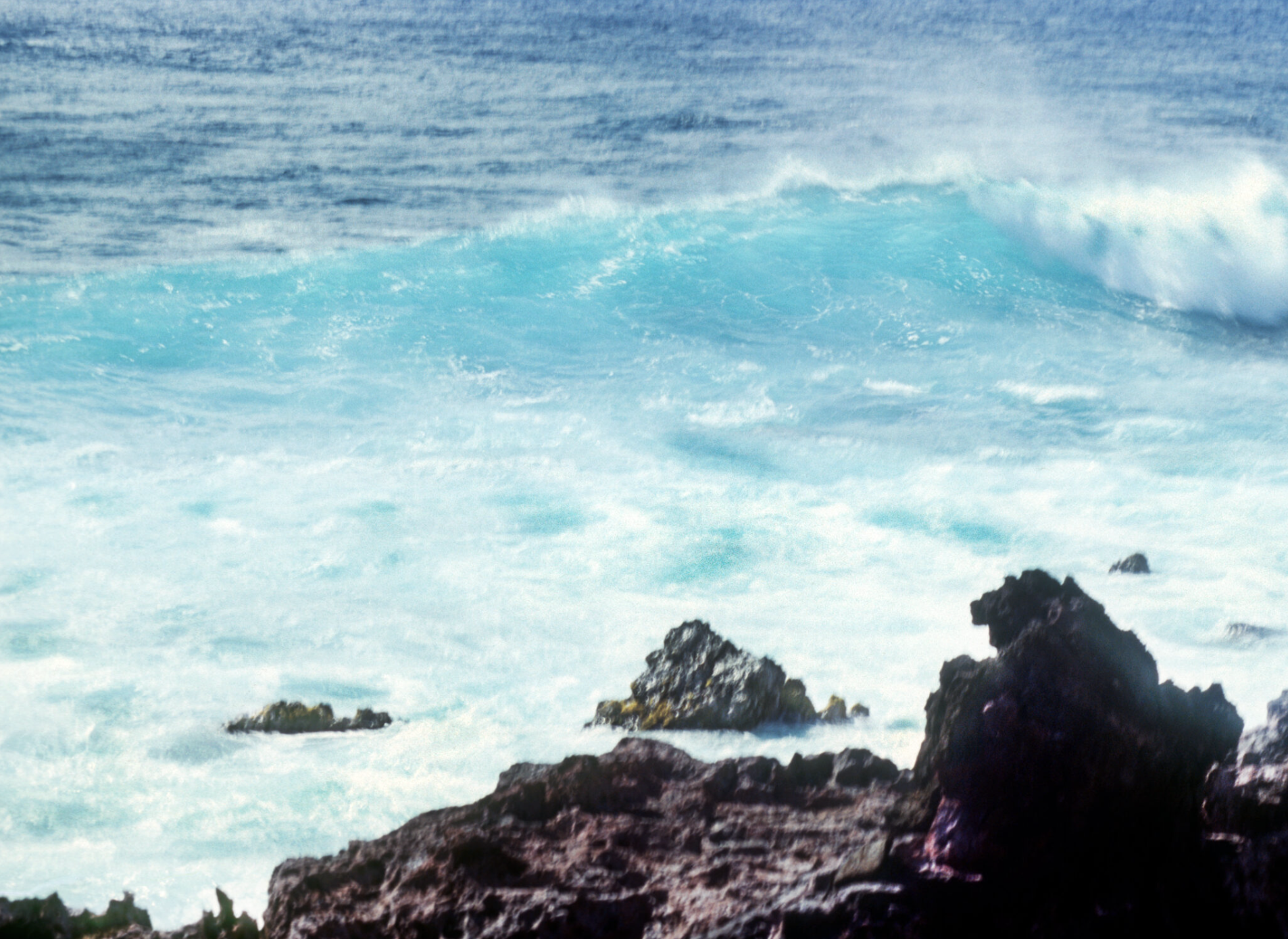At the World’s Edge on Easter Island
A first-time visitor explores the mythical, mystical landscape of Rapa Nui.
WORDS BY T. COLE RACHEL, PHOTOGRAPHY BY MARCELO GOMES
ARRIVING ON EASTER ISLAND is like a fever dream. The first thing I see when getting to my hotel after nearly 20 hours of travel is a vast expanse of volcanic shoreline just beyond the property’s grounds. Huge waves smash against the jagged black rocks, and even though it’s not too hot, the sunlight feels exceptionally intense. As I stand and stare, I spot two girls, no older than 11 years old, riding a horse down the road that skirts the beach’s edge. The horse is at full gallop, and they are riding saddleless, with only the horse’s unkempt mane to hold onto. Just as they reach the periphery of the hotel grounds, the horse abruptly digs in its hooves and bucks wildly, throwing the girls into the air like rag dolls.
From my vantage point, I cannot see where or how they land; the horse simply trots a few more feet and then pauses to nibble some grass. “Oh my God!” I say to the concierge, who is leading me to my room. “It’s fine,” he says. “There are probably more horses on this island than people.” This doesn’t seem a proper response to what I’ve just witnessed, but as I scan the beach, I see that the girls have already rebounded. They pat the horse before leading it to a large rock so they can once again pounce onto the animal’s back. Within a few minutes, they’ve disappeared from view, audibly cackling in the distance as the horse once again ramps up to full speed. “See?” says my concierge, “The horse was fine.”
This seems a proper welcome to a destination as weird and wonderful as Easter Island. I’ve come here to satiate a lifelong fascination with a place that has been a source of curiosity for me since I, too, was a horse-riding child — but on a farm in Oklahoma. If you grew up in the 1970s, Easter Island was perhaps second only to the Bermuda Triangle as a source for mysterious speculation. Shows like Leonard Nimoy’s “In Search of…,” a spooky precursor to “Unsolved Mysteries,” frequently posited the island, with its enormous, otherworldly stone head statues set in the unusual topography, as a playground for aliens and the home base for an ancient race that modern humans might never understand. Across pop culture, the stone figures, named moai, were an oft-misappropriated symbol of cosmic mystery, popping up where you might least expect them. I remember staring for hours at one of my dad’s albums — 1978’s “Pieces of Eight” by Styx — the cover of which shows a very intense-looking woman wearing stone moai as earrings. I nearly broke my childhood mind while listening to that record and wondering: What can it possibly mean?
Easter Island, or Rapa Nui as it is properly named, is situated in the middle of the southern Pacific Ocean. It is not the kind of place one casually visits. My own journey from New York City involved a 10-hour flight to Santiago, Chile, followed by another five-hour flight to the island itself. There are only a handful of flights to Easter Island per week, and even though it boasts a surprisingly large airstrip — built as a never-used backup landing spot for space shuttles — the airport itself is tiny. While it’s possible to reach the island by boat, locals (of which there are less than 8,000) have thwarted cruise lines by refusing to build a larger port.
“Known for being one of the most remote inhabited islands in the world, it emits a feeling that is simultaneously unassuming and mystical.”
Furthermore, outside businesses are generally not allowed on Rapa Nui, and it’s impossible to buy property on the island unless you are truly a local. This means you won’t see a single chain store or any large hotel franchises. I learned this after inquiring about the large number of people on my flight toting boxes of baked goods back to the island from Santiago. Dunkin’ Donuts, in particular, is considered a rare treat for Rapa Nui locals. Even though the island is a territory of Chile, it’s a place that seems to operate according to its own rules and logic. Known for being one of the most remote inhabited islands in the world, it emits a feeling that is simultaneously unassuming and mystical. Though it’s hard to articulate, I am struck by the palpable feeling of being very far away from … well, anything.
“Our remoteness is what makes us so special,” says my guide, Nicolás Pakarati Trengove (Nico, for short). Born and raised on the island, he spent years on the mainland training to be a pilot before deciding to return to create his own farm, where he now grows bananas and pineapples and raises horses. He also serves as the occasional tour guide. “It’s not easy to come here, so you have to really want to see the island,” he explains. “Everyone here is very friendly and happy to have tourists come, but people from Rapa Nui are very protective of the island itself. It would not be wrong to say that locals are happy to have visitors come here … just not too many of them.”
Like most people who visit Rapa Nui, my primary objective is to see the iconic moai, of which there are more than a thousand, placed at various points around the island. On my first morning, Trengove drives me to Rano Raraku, a site commonly known as the quarry, to see where 95% of the moai were created. On our way, we cross the island’s interior. It’s surprisingly pastoral: green hills, scrubby patches of farmland (the island is famous for a particularly demure variety of tiny pineapples, available only here), and the occasional unexpected formation of rocks, many of which turn out to be ancient chicken coops. Several times, the path is blocked by small groups of horses, most of whom roam the island unfettered and unbothered. Ahead of us is the looming volcanic crater, dotted with dozens of moai in various shapes, sizes, and stages of completion.
“Created in honor of their ancestors, the moai face inland, looking over and protecting the villages.”
Despite having seen the moai in photos my entire life, nothing quite prepares me for seeing them in person. The stone monuments are massive and much more ornate than I imagined. They have arms and ears but generally no legs. At one time, they also had eyes made from coral and obsidian. The trunks of their bodies are typically buried deep in the ground, which means they are even bigger than they appear. As we hike a winding path up the side of the volcanic quarry, Trengove gives me a CliffsNotes version of Rapa Nui history. He explains what is known — and still unknown — about the rival clans of early Polynesians who lived on the island and the complicated social systems involved in the building, transport, and placement of these massive stone objects.
Created in honor of their ancestors, the moai face inland, looking over and protecting the villages. As we go higher, one can see half-finished moai still frozen on the sides of the mountain. Some appear almost fully formed, while in other places a partial face and faint features will emerge from the earth. At the top of the quarry, we pause to take in the view — a bewildering vista of scattered stone heads that gives way to rolling grassland, all skirted by jagged volcanic rocks and an ocean that stretches out into infinity. There is no gift shop here, no crowds, and only minimal signage. Standing on a rock outcrop, I realize there are no other people in sight. “I guess this is why I could never move away for good,” Trengove tells me, looking out towards the ocean.
There is an assortment of small hotels on Rapa Nui, most of them essentially tiny motels, but I am staying at the Nayara Hangaroa. This large luxury property is managed and operated by Nayara Resorts, which also have a variety of sustainably minded and eco-friendly hotels in Chile, Costa Rica, and Panama. While the Rapa Nui property is still locally owned, it bears all the hallmarks of other Nayara properties — architecture that reflects the area’s landscape (in this case, round stone buildings with green-grass roofs that mimic the ancient Indigenous dwellings), an incredible restaurant, and a stay that is centered around giving guests an authentic experience of the place. Rapa Nui closed itself off entirely during the height of the pandemic, but since reopening in August of 2022, the resort has had a slow increase in visitors. Still, during my time there, I see more wild horses roaming around than people.
Though I am only on the island for a few days, I quickly fall into a rhythm. On my daily drives to the moai with Trengove, I get a sense of just how small the island is — about 63 square miles. It’s particularly astounding to me that, while the figures themselves are carved from a specific volcanic rock found at the quarry, the round stone hats, or pukao, often seen atop the moai are carved from a different variety of red rock, quarried from an entirely different location. Trengove explains the various theories of how these massive objects were moved from one side of the island to another: ropes, rolling logs, rudimentary cranes and pulley systems, the muscle power of thousands of people lifting in tandem. But he admits that no one knows exactly how it was done or, for that matter, why. “I think all of the theories are, in some way, a little bit true,” he tells me.
Though there are many striking beaches on Easter Island, most are nicer to look at than swim around. Even though Rapa Nui is a dream for scuba divers — thanks to the crystalline waters that surround it — much of the coastline is rocky. However, there are a handful of sandy beaches and one afternoon I make my way to the most popular public one, Anakena. It is presided over by a row of large moai and is said to be the landing place of Hotu Matu’a, the Polynesian chief who was part of a two-canoe expedition that supposedly founded the first human settlement on Rapa Nui. Despite being the biggest and busiest public beach, it is shockingly pristine and uncrowded. I go out for a late afternoon swim, delirious from the intensity of the sunlight and sad that my too-short visit is soon ending. Floating in a kind of haze while staring at the moai on the beach, I feel my soul leave my body when something big and definitely alive grazes my leg. I look down to see an enormous sea turtle leisurely swimming past.




That night I walk out to the cliffs at the island’s edge. I’ve come here every night since arriving, and it’s the perfect vantage point for watching the sunset, which is nothing short of psychedelic. Even though it seems almost pointless, each night I take the same photo, trying to capture some semblance of just how beautiful it is so I can never forget. I linger until it’s dark and I can hear, but no longer see, the waves crashing on the rocks.
On my last day on Easter Island, I wake up at 5 a.m. to meet a small group in the hotel lobby. We are going to see the sunrise at Ahu Tongariki, a craggy beach that is home to one of the largest and most striking clusters of maoi. Though I am generally skeptical of “once-in-a-lifetime” experiences, this appears to actually be one. We drive in sleepy silence through the inky dark, occasionally stopping to let small gangs of horses pass in front of us. Once we arrive at the beach, it’s so dark out that I haven’t noticed the storm clouds overhead until what can only be described as a biblical downpour begins. A few of us huddle together, but we’re quickly resigned to the fact that we’re going to be soaked. Our guide apologizes for the downpour, concerned that the rain will impede what is normally one of the most dramatic places on Earth to see the sunrise. He needn’t have worried. When the sky eventually begins to lighten — a light purple, then pink silhouetting the massive stone figures in front of us — it feels oddly appropriate to be lashed by the rain while standing in this intense, ancient space. As the sun slowly reveals itself, the rain subsides and it’s suddenly warm again, everything wet and slightly glowing. We are silent. Looking up at the statues’ expressionless stone faces, it is the furthest I’ve ever felt from home, and the most alive I’ve felt in years.





